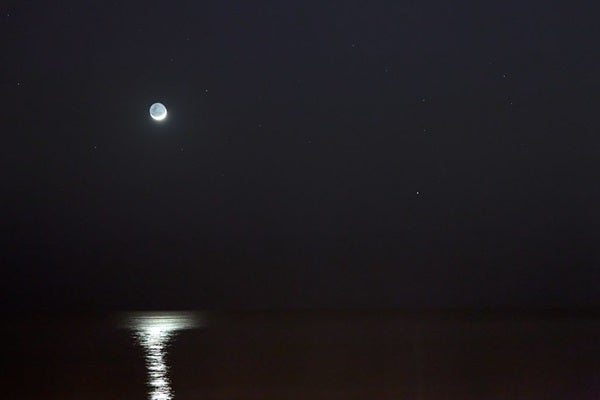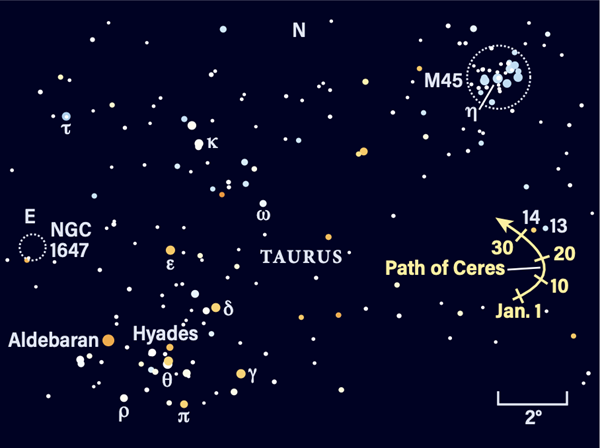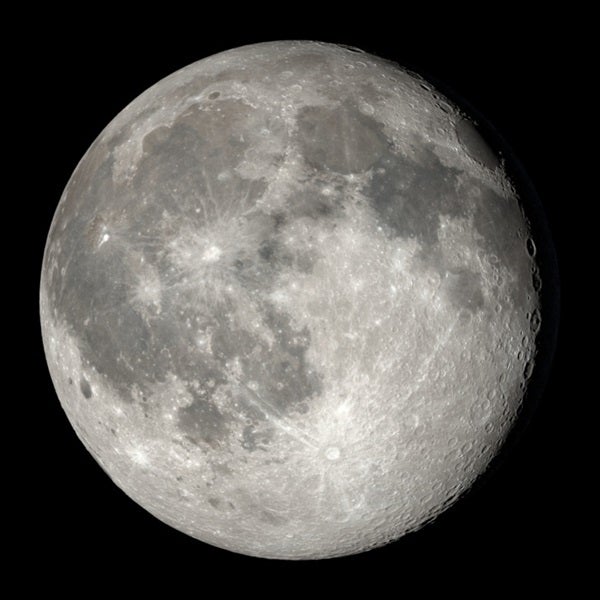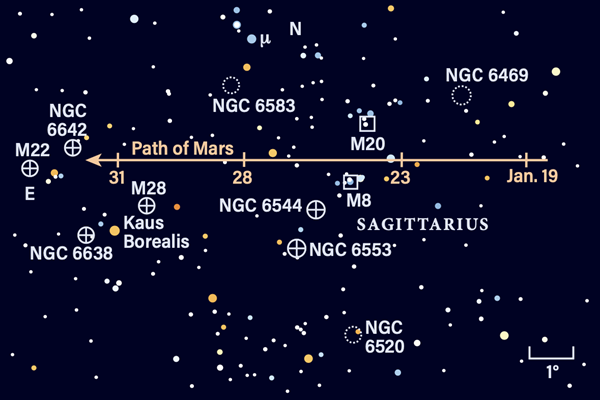Friday, January 14
The Moon reaches apogee, the farthest point from Earth in its orbit, at 4:26 A.M. EST. At that time, our satellite will be 252,155 miles (405,804 km) away.
With the bright Moon in Taurus tonight, let’s cast our gaze across the sky to Pisces to discover one of the sky’s reddest rubies. 19 Piscium, also called TX Piscium, is a deep red carbon star. This means it’s in the later stages of its life and has puffed up into a cool red giant. That alone will make a star appear redder, but carbon stars go one step further: These stars have abundant carbon in their atmosphere, which readily scatters blue and green wavelengths of light so only the red can shine through. Thus, carbon stars appear particularly red.
To find 19 Psc, step outside early in the evening, before Pisces has sunk too low in the west. Look for the Circlet of Pisces, an asterism formed by seven stars, one of which is 19 Psc. The other stars in the Circlet are Gamma (γ), 7, Theta (θ), Iota (ι), Lambda (λ), and Kappa (κ) Piscium. Gamma, at magnitude 3.7, is the brightest. 19 is located about halfway between Lambda and Iota, just east of a line drawn between them.
19 Psc is a variable star, swinging between magnitudes 4.9 and 5.5. Your best bet is to use a telescope or binoculars to pick out its deep, ruddy glow against the dark background sky.
Sunrise: 7:21 A.M.
Sunset: 4:58 P.M.
Moonrise: 2:09 P.M.
Moonset: 4:48 A.M.
Moon Phase: Waxing gibbous (91%)
*Times for sunrise, sunset, moonrise, and moonset are given in local time from 40° N 90° W. The Moon’s illumination is given at 12 P.M. local time from the same location.
Saturday, January 15
If you’ve got a larger telescope and plenty of patience, we’ve got a challenge for you: globular cluster Palomar 5. This 7′-wide blob of stars is one of the more difficult globulars to spot, but you’ve got a chance this morning between the time the Moon sets and when twilight starts to brighten the sky. Ideally, you’ll want a dark site and a good view of the southeastern horizon to find this softly glowing prize.
Discovered in 1950, Palomar 5 has a total magnitude of 11.8. That isn’t too bad, but it’s spread out over the cluster, giving it a low surface brightness that makes it harder to spot. Begin by finding magnitude 3.5 Mu (μ) Serpentis, then skimming 9° west-northwest to land on the cluster. Astronomy’s editors recommend using a magnification of 75x with an 11-inch telescope to search out this cluster, and even larger scopes will further improve your chances.
If you can’t find it, don’t give up hope of seeing a globular cluster this morning — instead try looking 9.5° northwest of Mu. You’ll land on the much easier-to-see, magnitude 5.6 M5. Any size instrument should pick this one up with ease, especially if the sky is still dark.
Sunrise: 7:20 A.M.
Sunset: 4:59 P.M.
Moonrise: 2:53 P.M.
Moonset: 5:45 A.M.
Moon Phase: Waxing gibbous (95%)
Sunday, January 16
Pluto is in conjunction with the Sun at 10 A.M. EST. After today, it will slowly separate from our star, moving toward opposition later this year.
Dwarf planet 1 Ceres is stationary at 5 P.M. EST. You can find it after dark in Taurus, less than 6° south of the Pleiades (M45) open star cluster. This 600-mile-wide (966 km) main-belt world glows around magnitude 8, easy for even the smallest scope to pick up, although binocular users may find it a bit of a challenge. One easy way to spot it is to put the Pleiades at the northern edge of your field of view, then drop down to find the stars 13 and 14 Tauri, both about 6th magnitude. Ceres is the next-brightest dot in your field of view, slightly south of this pair.
The dwarf planet will stay in this region of sky all month, now making a tight turnaround and traveling very slowly northeastward, approaching 13 and 14 but passing just southwest of them on its path through the Bull.
Sunrise: 7:20 A.M.
Sunset: 5:01 P.M.
Moonrise: 3:44 P.M.
Moonset: 6:38 A.M.
Moon Phase: Waxing gibbous (98%)
Monday, January 17
Venus, which dominated the evening sky in early January, has now just begun to peek out shortly before sunrise. If you’re up early, see if you can find the bright planet amid the brightening sky. Just 30 minutes before sunrise, Venus floats a mere 7° high in the east. But it shouldn’t be too hard to find: It’s glowing a bright magnitude –4.3.
With a telescope, you’ll see its 1′-wide disk is just 3 percent lit. Through the rest of the month, you’ll see that disk shrink to about 50″ but grow more illuminated, reaching 15 percent lit on the 31st.
To the upper right of Venus in the sky is Mars, shining at magnitude 1.5. The Red Planet spans a mere 4″ — not much to look at through a telescope, but it’s beginning a trek through a gorgeous region of the Milky Way with plenty else to see. Stay tuned, we’ll come back to this target later in the week.
Full Moon occurs at 6:48 P.M. EST tonight. January’s Full Moon is also colloquially known in the U.S. as the Wolf Moon or, sometimes, the Ice Moon. If you can’t catch the year’s first Full Moon tonight, don’t worry — our satellite will appear Full (or nearly Full) for another day or so as it slowly begins to wane.
Sunrise: 7:19 A.M.
Sunset: 5:02 P.M.
Moonrise: 4:41 P.M.
Moonset: 7:26 A.M.
Moon Phase: Full
Tuesday, January 18
The planet Uranus is stationary at 3 P.M. EST. It’s floating high overhead in Aries after dark tonight. All of Aries’ bright stars are in the northwestern portion of the constellation, while Uranus is located in the southeastern region, about 11° southeast of Hamal. (At magnitude 2, this is the Ram’s brightest star.)
If you’d like a closer beacon to locate the ice giant, look instead to 4th-magnitude Mu Ceti in Cetus the Whale. This star is located just 5.3° southeast of the planet. With binoculars or a telescope, zoom in and you’ll pick up magnitude 5.8 Uranus a little less than 0.5° south of 6th-magnitude 29 Arietis. The distant planet spans 4″ in a telescope — the same apparent size as Mars, although the two are of course physically very different in size. It’s Uranus’ vast distance that makes it appear so small: It’s currently some 1.8 billion miles (2.9 billion km) from Earth.
Sunrise: 7:19 A.M.
Sunset: 5:03 P.M.
Moonrise: 5:43 P.M.
Moonset: 8:07 A.M.
Moon Phase: Waning gibbous (99%)
Wednesday, January 19
The Moon has just begun to wane from its Full phase, appearing some 95 percent lit by this evening. After it rises, take a look at our satellite to try and spot the slowly encroaching shadow of night just starting in the lunar east (west on the sky).
With just a sliver of its limb gone, some of the features in this region now stand out in stark contrast, thanks to the moving terminator (the line separating night from day). One of the most noticeable is Mare Crisium (the Sea of Crises) in the northeast. This round, flat sea spans some 345 miles (550 km) and likely formed between 4.5 billion and 3.8 billion years ago. To its southwest, still in broad daylight, is the large Mare Tranquillitatus, better known as the Sea of Tranquillity and the landing site of Apollo 11, the first manned mission to the Moon.
Sunrise: 7:18 A.M.
Sunset: 5:04 P.M.
Moonrise: 6:46 P.M.
Moonset: 8:43 A.M.
Moon Phase: Waning gibbous (97%)
Thursday January 20
It’s time to get in your last good views of Jupiter for a while. By the end of the month, the planet will be only 11° high an hour after sunset, requiring observers to look through more layers of Earth’s turbulent atmosphere and muddying the view of this stunning planet.
Today, the gas giant is still 20° high an hour after sunset, located in southwestern Aquarius. By this time, Mercury and Saturn have disappeared, leaving Jupiter’s magnitude –2.1 glow to rule the western sky. Zoom in on the planet with a telescope to see all four of its Galilean moons: Europa (farthest) and Io to the east, with Callisto (closest) and Ganymede to the west.
Keep watching, and you’ll see Io cross onto the disk around 8 P.M. EST. Its shadow follows about 45 minutes later, as Io is nearly a quarter of the way across Jupiter’s face and the planet is about to set in the Midwest. West Coast observers can keep watching a bit longer to see Io slip off the disk around 7:15 P.M. PST. Unfortunately, Jupiter will set before you can catch Io’s shadow following suit.
Sunrise: 7:18 A.M.
Sunset: 5:05 P.M.
Moonrise: 7:51 P.M.
Moonset: 9:13 A.M.
Moon Phase: Waning gibbous (93%)
Friday, January 21
Early risers are in for a treat during the last few weeks of January. Starting today, the planet Mars skims beneath open cluster NGC 6469 on its way to visit the Trifid (M20) and Lagoon (M8) nebulae.
The Red Planet rises about two hours before sunrise. Wait at least 30 to 40 minutes for it to clear the most turbulent part of the atmosphere, then turn your telescope toward western Sagittarius, now sitting to the lower left of Scorpius and directly below Ophiuchus. The higher you can let it get before the sky brightens too much, the better.
NGC 6469 is less than 2° northeast of Mars this morning, which will appear directly south of this young grouping of stars at the same time tomorrow. M20 currently sits 3.1° east-northeast of Mars, and M8 about 3.5° east-southeast of the planet. You should be able to catch the whole thing with binoculars, or zoom in on various targets with a telescope for greater detail in each.
Mars will continue east and slip between these two nebulae in a few days, so we’ll certainly continue to revisit this scene in future columns to keep you up to date.
Sunrise: 7:17 A.M.
Sunset: 5:06 P.M.
Moonrise: 8:56 P.M.
Moonset: 9:40 A.M.
Moon Phase: Waning gibbous (86%)














